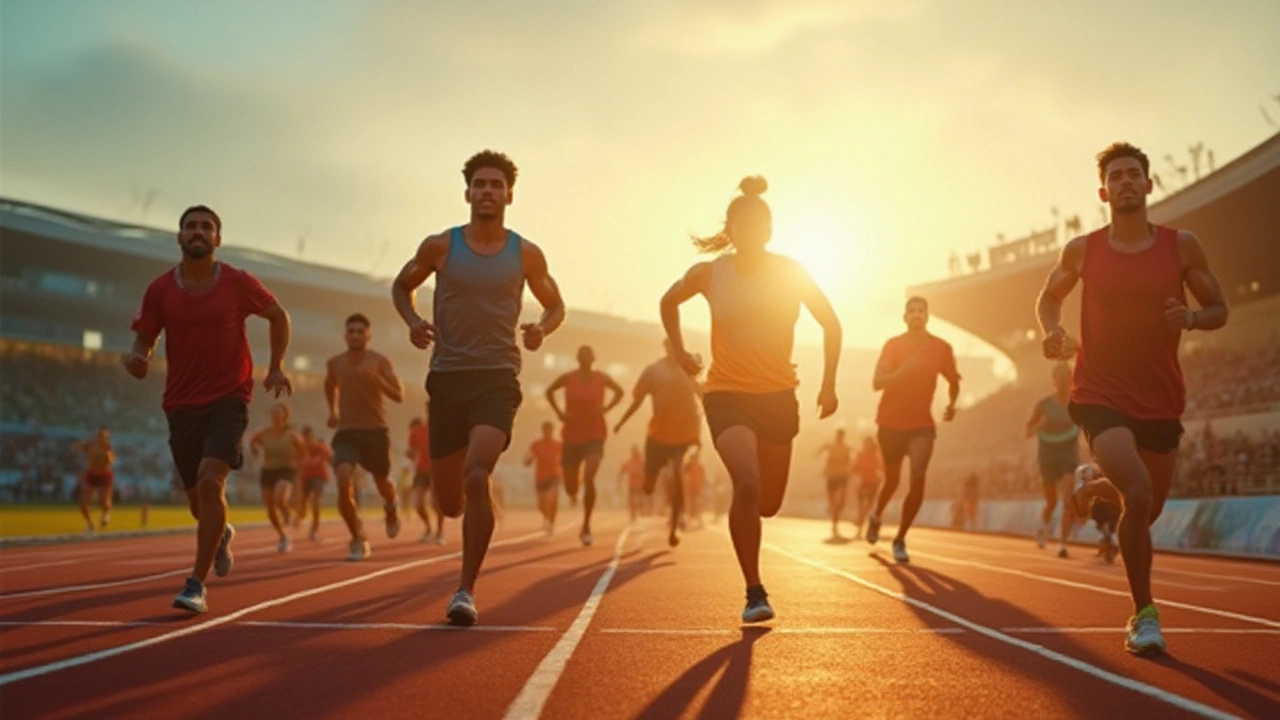Picture this: The stadium lights are blazing, cameras flash, and a star athlete steps onto the field. Everyone wants to know what it takes to stand in those shoes. It’s more than just raw talent or working out until you drop. Behind every pro’s victory are routines, setbacks, and science-backed strategies that most fans never see. What keeps elite competitors at the top? Turns out, it’s not always what you think. Let’s pull back the curtain and lay out what pro athletes genuinely need—from feeding their bodies all the way to keeping their heads in the game. These needs cut across sports, whether you’re hitting sixes at Wankhede or swimming laps in Bandra. If you’ve ever dreamed of taking your game to superhuman heights, here’s the straight talk.
Physical Training: Building and Maintaining Elite Athleticism
The myth that pro athletes magically “wake up like this” just doesn’t match reality. Building extraordinary athletic bodies is a full-time job and then some. It starts with scientifically planned programs shaped by high-level coaches and performance labs. Take Virat Kohli—he redesigned his training after skipping cheese-loaded Indian curries for lean protein and HIIT sessions. Pro athletes live by routines that are tailored, not random. Strength and conditioning, speed drills, agility workouts, explosive plyometrics, and skill repeats—these aren’t optional add-ons; they’re daily bread. For example, footballers at Manchester City might train twice daily: first in the gym working on mobility and lower-body power, and later, team sessions focusing on game tactics and endurance. Cricket players meticulously train flexors and deltoids to prevent shoulder injuries from repetitive bowling. Pro swimmers split their weeks between pool intervals and dryland resistance, always logging their splits for minute improvements.
But it’s never a one-size-fits-all recipe. Athletes’ bodies are all wildly different. Top programs depend on genetic testing, muscle composition studies, and constantly tweaking plans to adapt to seasonal goals. Even sleep gets tracked—tennis players like Novak Djokovic use sleep pods to optimize recovery cycles. Athletes must also dial back when the body calls for rest, integrating deload weeks and active recovery days. Smarter training beats ‘more’ training. Overtraining doesn’t equal greatness; it means more injuries. Pro setups use sports scientists to read force plates, 3D-motion sensors, and blood markers, looking for signs of stubborn fatigue. If there’s a microtear in the muscle or a hormonal imbalance, that day’s script is rewritten. The goal: longevity, not just a flash-in-the-pan season.
Progress gets measured, not guessed. Everything from how much weight they lift to their vertical jump on Monday compared to Thursday gets logged. Pro athletes chase incremental wins—maybe adding 1kg to a squat or shaving a tenth (yes, just a tenth) of a second off a sprint. Margins like this make all the difference between being a team pick or riding the bench. Elite performance isn’t just about who hustles more—it’s about who trains smart, tracks honestly, and adapts quickly when things change. If you want to act (and look) like a pro, find a routine that’s smart, not just hard, and invest in those tiny measurable wins.
Nutrition: Fueling Performance and Recovery
If you’re picturing athletes shoveling piles of chicken breast and pasta, that’s only half the story. Nutrition is a science, and every single bite—they count. Pro athletes need more than just calories; they need a fine-tuned balance of macro and micronutrients, timed to match heavy workouts and recovery periods. Usain Bolt famously downed chicken nuggets during the 2008 Beijing Olympics—sounds wild, but nutritionists gave him the green light since his body was accustomed to their sodium and protein content, and Chinese food safety concerns left limited options. For most pros, though, nutrition plans are as personalized as phone passcodes. Carbs for energy, lean proteins for repair, healthy fats for hormones, and a rainbow of veggies for anti-inflammation. It’s all mapped out by registered dietitians who understand the demands of 110-minute football matches or a week-long Grand Slam.
Hydration is a constant battle. You won’t see a marathoner without their own bottle, measured to suit their sweat rate. Even a 2% dip in hydration can slow an athlete’s reflexes and fog up decision-making, something coaches in NBA have been tracking since players started logging water breaks on apps. Mineral balance matters too. Cricketers in Chennai’s heat, for example, get sodium and potassium-rich drinks, sometimes laced with amino acids or beet juice to boost blood flow. Supplements? Only after nutrition basics are covered. Banned substances are a minefield—one misstep, and reputations collapse faster than a T20 run chase. That’s why teams work closely with lab-tested, certified products.
Recovery meals might include chocolate milk, turkey wraps, or simple banana-peanut smoothies—always timed within 30 minutes post session, a window when bodies soak up sugars and protein the fastest. It’s surprising how routine some diets can be, but there’s no room for guesswork. A study out of the Australian Institute of Sport found that properly timed carb-protein combos post-exercise led to 20% less soreness and a quicker muscle rebuild. Planning every meal, snack, and even late-night refuels helps pro athletes push their limits without crashing. Forget wild diet fads—pros look for food that delivers, every single day. If you’re thinking of leveling up, keep a food diary, see a sports nutritionist, and remember timing is often as important as what’s on your plate.

Mental Strength: How Mindset Separates the Greats from the Rest
Talent and hours in the gym mean nothing if your brain taps out under pressure. This is where pro athletes draw the real line. Mental strength is built, never assumed. Simone Biles, Michael Phelps, and even Virat Kohli have all spoken openly about battling anxiety, burnout, and overwhelming highs and lows. While outsiders see the fame and glory, pros know that focus and emotional balance are just as important as a killer serve or six-pack abs. Psychologists work with them to build mental playbooks: meditation, visualization, self-talk, and even controlled breathing like ‘box breathing’ (inhale for 4 counts, hold for 4, exhale for 4, hold for 4—repeat) during games to reset nerves.
Handling criticism is a skill most never master. Imagine waking up to a flood of angry tweets after a missed catch—pro athletes don’t get to “switch off” from the spotlight. Sports psychologists arm them with coping mechanisms. Some keep gratitude journals, others establish off-pitch boundaries—LeBron James takes ‘phone-off’ periods before games. Studies by Stanford’s sports lab show that athletes trained in reframing negative thoughts recover from mistakes 55% quicker. That’s the difference between staying in the zone or spiraling after a bad call.
Big moments demand clutch mental routines. Cricket finishers like MS Dhoni swear by focusing only on the next ball, blocking out what-ifs. Tennis champions have rituals before every serve: Rafael Nadal’s bottle placement isn’t superstition, it’s a focus exercise to anchor nerves. Visualization isn’t “woo” either—NBA players watch themselves making shots, while swimmers imagine each stroke before finals. Off the field, having hobbies helps. My own dog, Rocky, helps me reset after writing marathons (pun intended), so you can imagine the power of pets, music, art, or even video games in decompressing after high-pressure tournaments.
If you’re chasing pro-level consistency, practice resilience as much as reps. That means learning to let go of mistakes, celebrating small wins, and not letting critics set your self-worth. Even if you’re not playing to packed stadiums, building routines to manage pressure is a pro move anyone can borrow.
Recovery: Rest, Sleep, and Injury Prevention
Here’s the not-so-glamorous truth: Most pro athletes spend as much energy avoiding injury as on game skills. Recovery isn’t just about plopping down after a workout. It’s calculated and part of the daily grind. Usain Bolt once said he trained hard for two hours but rested for 22—the math might be exaggerated, but the philosophy isn’t. Recovery starts immediately after training: foam rolling, contrast baths, targeted stretching, and sometimes even cryotherapy or infrared saunas. Physiotherapists are ever-present, checking for hints of tightness or overuse.
Sleep is king. NFL teams in the US now have ‘sleep coaches’ and track REM cycles for all their players, sometimes cutting down practice if sleep data shows fatigue. There’s a reason Roger Federer clocked 10-12 hours a night during tournaments; it's non-negotiable for memory, muscle repair, and immune function. A study published in the British Journal of Sports Medicine tracked 80 elite cyclists and found those getting 9+ hours of sleep performed 8% better over race weeks.
Prevention is always better and cheaper than rehab. Simple habits matter: warming up with dynamic stretches, cooling down with active movement, and addressing “niggles” before they balloon into real injuries. Kinesiology tape, compression wear, and even custom orthotics are standard kit bag items—not fashion statements. Many pros love massage guns now, but don’t skip the basics: twice-weekly massage, regular ice packs, and honest injury reports trump tech. Nutrition supports recovery too—a morning turmeric shot can reduce inflammation, while evening magnesium-rich snacks help sleep.
Comeback stories are great, but smart pros spend more time staying fit than fighting to return. That means listening to the body, taking scheduled ‘off days,’ and never ignoring warning signs, even if it means sitting out an important match. Want to stay on your feet season after season? Prioritize rest as highly as you do training, and make it part of every plan, not a last-minute fix.

Community, Support, and Sacrifice
Behind every medal or match-winning moment is a crew that never makes headlines. Coaches, physios, nutritionists, families, friends, and even pets—these people (and sometimes animals) hold pro athletes together. It’s a myth that champions are lone wolves. Take Serena Williams, whose coach, hitting partners, and physio have been her anchors since her teens. Teammates, even rivals, push each other to new heights. Messi regularly credits his childhood mentor for keeping him grounded, and closer to home, Indian athletes often talk about joint family support during tough travel tours.
Accountability grows when you’re not going at it alone. Regular check-ins, supportive words after flubbed plays... they all matter. Athletes talk through rough patches, iron out tactical mistakes, and even share rooms to build trust and chemistry. Pros become students of their own limits. Stepping up means sacrificing nights out, managing media noise, missing birthdays, and sometimes learning to let go of unhealthy relationships. But it’s not a sacrifice unless there’s something to give up. That’s the big difference between good and great athletes: willingness to say ‘no’ for bigger long-term wins.
Community extends to fans, too. Positive support—whether it’s the roar of a crowd at Eden Gardens or kids waiting outside Dadar station for autographs—drives athletes through slumps. Social media can be a double-edged sword, but when channeled right, it gives athletes a sense of purpose beyond trophies. Many give back, running grassroots camps or sharing their journeys to inspire the next gen. They pay it forward, knowing greatness grows best in a garden, not a silo.
So, if you’re aiming to play like a pro, don’t go solo. Build a circle, find mentors, cherish true friends, and know when to lean on others. No one stands on a podium alone—even when the medal is heavy, the journey is shared. That’s how stars are made, both on and off the field.

